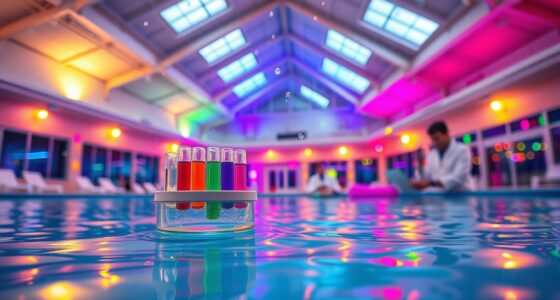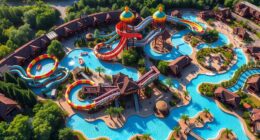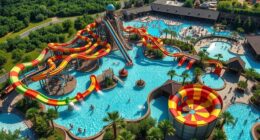Choosing between chlorine and saltwater systems for your indoor water park depends on your budget, maintenance capacity, and guest comfort goals. Chlorine offers quick sanitation and lower upfront costs but requires manual chemical handling and produces irritants. Saltwater systems generate continuous chlorine, reducing chemical labor and providing softer water, but involve higher initial expenses and potential equipment corrosion. To learn how each system impacts long-term costs, water quality, and guest experience, keep exploring these options.
Key Takeaways
- Saltwater systems offer softer water and fewer chloramines, enhancing swimmer comfort and reducing irritation compared to traditional chlorine.
- Traditional chlorine pools provide rapid sanitation suitable for high-traffic indoor environments with straightforward maintenance.
- Saltwater systems have higher upfront costs and corrosion considerations but may lower ongoing chemical handling expenses.
- Indoor saltwater pools require durable, corrosion-resistant materials to prevent damage to equipment and surroundings.
- Both systems should include backup power to maintain water quality during outages and ensure safe, continuous operations.
Cost Considerations for Setup and Operation

When comparing chlorine and saltwater systems, understanding setup and ongoing costs is essential. Saltwater systems typically require a salt chlorine generator, control panel upgrades, and an initial salt supply, adding $1,650–$3,850 to upfront costs compared to traditional chlorine setups. Converting an existing chlorine pool to saltwater costs between $500 and $2,500, depending on pool type. New saltwater pools average around $25,000, slightly more than chlorine pools at $23,000, due to extra equipment. Chlorine pools only need standard filtration and chemical feeders, costing $500–$1,500 initially. While saltwater systems have higher initial expenses, ongoing costs can be lower because of reduced chemical purchases, but they do incur higher electricity bills and salt cell replacement costs, influencing long-term expenses.
Differences in Sanitation and Chemical Management

Traditional chlorine pools rely on manually adding chemicals such as tablets, liquid, gas, or granules to maintain sanitizer levels, requiring frequent testing and adjustments. You need to constantly monitor water chemistry and add chlorine to keep bacteria and algae at bay. Saltwater systems automate this process by generating chlorine through electrolysis, providing a steady, lower chlorine level. Saltwater pools often have a more consistent chlorine level because of this continuous production. Additionally, chemical handling can pose safety concerns, especially in untrained hands. Manual testing and chemical addition are time-consuming. – Saltwater systems produce chlorine continuously, reducing fluctuations. – Traditional pools produce more disinfection byproducts like chloramines, causing odors and irritation. – Saltwater pools generate fewer chloramines, leading to less odor, eye, and skin irritation. These differences mean saltwater systems simplify chemical management and improve water quality, but they still require equipment monitoring and maintenance.
Impact on Swimmer Comfort and Experience

You’ll notice that saltwater pools generally cause less eye and skin irritation because they maintain steadier chlorine levels and produce fewer irritating compounds. The water also feels softer and less harsh, making your swim more comfortable and enjoyable. Plus, the absence of strong chemical odors means your experience won’t be marred by unpleasant smells or tastes. Saltwater systems naturally produce more stable chlorine levels, further enhancing swimmer comfort and reducing irritation. Additionally, the chlorine stabilization process in saltwater systems helps maintain optimal sanitizer levels over longer periods, contributing to a more consistent swimming environment.
Skin and Eye Irritation
Saltwater pools tend to cause less skin dryness and eye irritation because they produce chlorine more steadily and at lower levels, resulting in a gentler experience for swimmers. This consistent chlorination reduces the formation of chloramines, which are responsible for irritation and discomfort. When chloramines build up, you often notice red, itchy eyes and dry, irritated skin. Saltwater systems generate fewer chloramines, leading to a more comfortable swim. You’ll likely experience less redness and itching, especially if you’re sensitive or have allergies. Additionally, the water feels softer, and your skin stays more hydrated. Proper maintenance is still essential, but saltwater pools generally offer a more pleasant experience with fewer irritants. Lower chemical levels also contribute to a more natural feel in the water, enhancing overall swimmer comfort. – Fewer chloramines mean less eye stinging and redness – Lower chlorine levels reduce skin dryness – Less strong chemical odor and taste – Improved comfort for sensitive skin swimmers
Water Feel and Odor
Have you ever noticed how the water in a saltwater pool feels noticeably softer and silkier than in a chlorine pool? That’s because saltwater systems produce a gentler, more natural feel through electrolysis, making the water more comfortable for your skin and senses. Unlike traditional chlorine pools, which can feel harsher, saltwater pools tend to be smoother and less irritating. This softer water also contributes to a more relaxing sensory experience. Additionally, saltwater pools substantially reduce the strong chemical smell common in chlorine pools, creating a fresher environment—especially important indoors. The reduced odor and softer feel make swimming more enjoyable and less harsh on your skin and eyes. Overall, saltwater pools deliver a more pleasant, soothing experience that many swimmers prefer. Saltwater pools also generate fewer disinfection byproducts, which further enhances swimmer comfort and safety. Moreover, the chemical composition of saltwater pools contributes to their milder impact on the skin and eyes.
Maintenance and Operational Demands

Maintaining a traditional chlorine pool involves frequent manual chemical additions and constant monitoring of water chemistry, which can be time-consuming and labor-intensive. You need to regularly add chlorine in various forms and adjust pH levels to keep the water safe and balanced. This often means more frequent shock treatments to handle fluctuating chlorine levels. Traditional chlorine systems rely heavily on manual intervention, requiring pool owners or operators to be vigilant and proactive in chemical management. A chemical balance must be maintained continuously to prevent bacteria growth and ensure swimmer safety.
- Manual addition of chlorine chemicals in tablets, liquid, or granular form
- Continuous monitoring and adjusting of pH and chlorine levels
- Higher frequency of shock treatments due to chemical fluctuations
- Lower initial equipment costs but more hands-on maintenance
In contrast, saltwater pools generate chlorine automatically, reducing daily handling and dosing effort. While salt systems require monitoring of salt levels and generator output, they streamline overall maintenance, saving you time and labor.
Environmental Effects and Sustainability

You need to contemplate how both systems impact the environment through chemical use and material durability. Saltwater pools generate fewer harmful byproducts but can cause corrosion and soil salinization if runoff isn’t managed properly. Saltwater pools provide a more eco-friendly chemical management approach. Additionally, the durability of components in saltwater systems is often highlighted in product certifications, reflecting their focus on sustainability and reduced environmental impact. Meanwhile, traditional chlorine pools often involve more chemicals that may contaminate water sources and harm ecosystems.
Chemical Use and Impact
Chemical use in water park systems considerably impacts the environment and sustainability. With chlorine pools, you face frequent chemical additions, which produce disinfection byproducts like chloramines that pollute indoor air and irritate eyes, skin, and lungs. These byproducts can pose health risks to swimmers and staff with prolonged exposure. Manufacturing and transporting chlorine increase carbon emissions, raising the overall environmental footprint. Additionally, chlorine doesn’t fully eliminate pathogens like Cryptosporidium, risking environmental contamination through backwash or wastewater. Disposal of chlorine-contaminated water can harm nearby ecosystems if not managed properly. Conversely, saltwater systems generate chlorine on-site via electrolysis, reducing chemical transportation and storage. They produce fewer harmful byproducts, but their electrical use and potential wastewater discharge still warrant consideration.
- Chlorine produces harmful byproducts affecting air quality
- Manufacturing and transport increase carbon footprint
- Incomplete pathogen elimination can lead to environmental risks
- Proper disposal of wastewater is essential for ecosystems
Material Durability Concerns
Saltwater systems tend to accelerate corrosion of metal components like screws, heaters, lighting fixtures, and pool furniture because of salt buildup, which can lead to faster material degradation. This corrosion demands the use of durable, corrosion-resistant materials such as high-quality resin, plastics, or specialized metals like titanium and stainless steel. Salt splash-out in indoor environments also causes external surface corrosion, impacting landscaping and coping materials. Salt cells in saltwater chlorinators typically need replacement every 3 to 5 years, adding to maintenance costs and material wear. Concrete and plaster surfaces may degrade faster if not properly protected, requiring specialized coatings. Overall, saltwater pools demand more robust, high-quality materials to withstand environmental stresses, influencing long-term durability and sustainability. Saltwater pools also generate chlorine byproducts that can contribute to additional corrosion and material deterioration over time.] Additionally, the environmental impact of salt generation and disposal must be considered when evaluating sustainability.
Material Compatibility and Equipment Durability

Material compatibility and equipment durability are key factors when choosing between chlorine and saltwater systems, as each impacts the longevity of pool components differently. With chlorine systems, you benefit from minimal corrosion risk, preserving equipment, liners, and finishes. They require fewer specialized parts and are compatible with most pool types, reducing maintenance costs. In contrast, saltwater systems pose a higher corrosion threat, especially to metal components, unless made from resistant materials like titanium or specific plastics. Salt splash can also damage surrounding decks and landscaping, demanding additional protective measures. Saltwater equipment, including generators, needs more frequent maintenance and part replacements, leading to higher long-term costs. Proper material selection and regular inspections are essential for saltwater setups, while chlorine systems generally offer more straightforward durability. Saltwater systems can accelerate corrosion if not properly maintained or constructed with resistant materials.
Choosing the Best System for Your Indoor Water Park

Choosing the right water sanitation system for your indoor water park depends on several factors, including budget, maintenance capacity, and the desired swimmer experience. If you have a limited budget, traditional chlorine systems are more affordable to install and retrofit, with simpler equipment requirements. They also demand regular manual dosing and chemical storage, which may increase ongoing labor. Saltwater systems, while more expensive upfront, offer automated chlorine generation, producing softer water and reducing chemical handling. They typically require less daily maintenance but involve periodic salt level checks and generator servicing. Consider your long-term operational costs, staff expertise, and customer experience. Saltwater pools tend to provide a more comfortable, less irritating environment, whereas chlorine pools excel at rapid sanitation. Reliable backup power systems can be a valuable consideration for maintaining consistent water quality during power outages. Your choice should align with your facility’s financial and operational priorities.
Frequently Asked Questions
How Long Does It Take to Install Each System?
You can typically install a chlorine system in 1 to 3 days, thanks to its standardized, plug-and-play equipment that’s easier to set up. Saltwater systems usually take longer, around 2 to 5 days, because they require more complex electrical work, system calibration, and salt level checks. Your installation time will also depend on your pool size, existing infrastructure, and whether retrofitting or ventilation adjustments are needed.
Are There Any Safety Concerns With Saltwater Systems?
Saltwater systems might seem like the safest choice, but they do come with safety concerns. You need to handle chemicals carefully because salt can cause corrosion, damaging equipment and surfaces. Also, many assume saltwater eliminates chlorine completely, but it still requires chlorination for disinfection. Regular maintenance is essential to prevent equipment damage and guarantee water quality, making safety a continuous commitment rather than a one-time setup.
Can Existing Pools Be Converted Between Chlorine and Saltwater?
Yes, you can usually convert existing pools between chlorine and saltwater systems without draining or refilling, in most cases. You’ll need to install a salt chlorinator, balance the water chemistry, add the appropriate salt, and connect the system to your existing plumbing. It’s best to have a qualified technician oversee the process to guarantee safety and compatibility. Regular checks and maintenance keep the system running smoothly after your conversion.
Which System Has Better Long-Term Cost Savings?
You’ll find saltwater systems offer better long-term cost savings because, even with higher initial expenses, their lower ongoing chemical and maintenance costs outweigh those of chlorine systems. While the upfront investment is steeper, you’ll save money over time on chemicals, repairs, and maintenance. Plus, the gentler water quality reduces wear and tear, making saltwater pools more economical and easier to maintain in the long run.
How Do Maintenance Needs Change With Pool Size?
As the pool size increases, your maintenance needs grow more demanding. Larger pools require more frequent chemical testing, bigger shock treatments, and higher chemical dosages, raising operational costs. With saltwater systems, you’ll need larger or multiple salt generators, more frequent cell cleaning, and increased energy use. Overall, bigger pools demand more time, effort, and money to keep water quality high and equipment functioning properly.
Conclusion
Choosing between chlorine and saltwater systems is like picking the right partner for your indoor water park’s journey. Both have their strengths, but understanding their differences helps you make a confident decision. Think of it as tending a garden—you’ll nurture the system that best fits your needs, ensuring it blooms with safety, comfort, and sustainability. With the right choice, your water park will shine like a beacon of fun and cleanliness for years to come.










